
Mark makes music on Groovy
Sailing off into the sunset is a dream a lot of people share, and some even get the crazy idea to go ahead and actually do it. What’s it like? Here’s a glimpse of some of the things we do each day in our cruising lifestyle — kind of a behind-the-scenes look at our life of leisure aboard a sailboat in the tropics.

We have fun above and below water.
When we decided to cruise Mexico, we planned to anchor out pretty much 100% of the time. That way we could put more of our budget into a comfortable, newer boat, while keeping the day-to-day expenses to a minimum. Marinas in Pacific Mexico typically cost anywhere from $30-$50 a night or $600-$900 a month for a boat our size, so living “on the hook” at anchor can mean big savings.
But living on the hook has its ups and downs. Literally!! The Pacific swell keeps the boat in constant motion, frequently lurching it from side to side for hours, or even days, on end. Also, the beautiful ocean is often held hostage by red tide — or algae blooms — that cloak it in an unpleasant color and odor, and fill it with debris, making swimming impossible and dropping the water temps as much as 10-15 degrees Fahrenheit.

Ahh… warm water!!!
For the past week, however, we have had one ideal day after another (November, 2012, in Huatulco). The water has been turquoise and clear and in the high 80’s. The air has been sunny and warm, and the swell has been modest, jolting us awake with a jerk only once or twice a night, if at all. Our days have been spent swimming til our skin is wrinkled, kayaking in the bay, and walking the beach where the waves caress our feet with the warmest of sun-heated ripples.

The water in Huatulco is gorgeous
Life on the hook, even during these heavenly days, is not exclusively about umbrella drinks in the cockpit, however. Each day we have a few hours of work that needs to be done. Mark keeps us on track with this stuff, making lists and making sure we stick to them.
I always find my interest in these things wandering quite a bit, though. Left to my own devices, I’m afraid the list would soon be lost, and after a few weeks we’d be living in true squalor.

Who wants to quit swimming to do a bunch of boat chores??
Back when I lured Mark into this cruising lifestyle (well, let’s see, I think I dragged him into it by the ear!), we divvied up the responsibilities according to skill, inclination and interest, rather than going straight “pink” and “blue.”
Since I’ve worked with computers all my life and had cruised before, the chartplotter was easy for me to learn, and I became navigator and skipper while underway.

Mark keeps us on track with our boat chores. Notice: “clean bilge” is not yet crossed off…
In our RVing life I never tow the trailer and rarely drive the truck. Last time I tried parking the rig, I put us exactly perpendicular to the spot I was aiming for. Mark’s last docking experience with the boat went just about as well. So this division of labor has been a happy one.
I love technical things and understand the theory of many things on the boat, and I got a huge kick out of researching and specifying the boat’s major system upgrades. But when it comes to holding a wrench I am still flustered by which end is which. Mark was a professional service engineer for Xerox’s high speed (room sized) printers and grew up working on cars. He is a master when it comes to electro-mechanical troubleshooting and installation.

I like using a kid’s bazooka water gun to clean the bilge!
So, in exchange for putting all the responsibility for all the boat’s systems squarely in his lap, I volunteered to keep the bilge clean.
Having a clean bilge makes it is easier to notice when something isn’t right. Water in the bilge must be coming from somewhere. Is it salt water or fresh water? Guess who gets to find out! Hopefully if a chemical is leaking into the bilge it isn’t lethal!!
In our earliest days in Huatulco, “clean bilge” went on the to-do list (our engine’s packing gland material is getting old, so it drips now). Mark had the luxury of taking a snooze next to the open bilge compartment when he finished his items on the To Do list! I dawdled as long as I could.

Boat work done? Take a snooze!
I’ve found the easiest way to get water out of the bilge is to use a kid’s bazooka water gun. Ours has a pointy end that can get into the crevices, and it soaks up a good bit of water that can then be squirted in a pail. Doing a final squeegee pull with fresh water before putting the toy away has kept it in good working order.
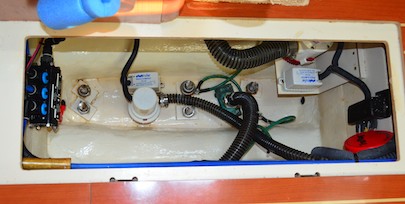
There, it’s done, and we have a clean bilge once again.
Living on the hook means that going ashore requires either a swim or a boat ride. So taking out the trash requires loading it in the dinghy first, and then finding a trash barrel on shore somewhere to throw it away.
The kayak works for this task too. The cool thing is that after the trash is gone you’re free to go exploring either on foot ashore or in the kayak.

Time to take out the trash!
Getting the laundry done also means loading it up in the dinghy and then lugging it to a laundromat — that is, if there is a laundromat somewhere nearby! In most Mexican ports laundry service isn’t hard to find.

Everyday we wash yesterday’s clothes in the sink. We wear light clothing around here and it’s an easy task.
Here in Huatulco the laundromat is a cab ride away — in addition to the dinghy ride to shore. Once you get there a woman washes and folds it for you (for 15 pesos per kilo, or about $4-$5 USD per load). But you don’t get it back til the next day!! (Ahem — that means another combo dinghy ride / cab ride to pick the laundry bags up…). If you splurge and stay at the marina, you can have your laundry picked up and delivered back to the boat for 20 pesos a kilo…
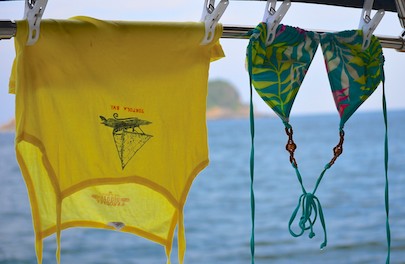
Luckily there are lots of places to hang the laundry out to dry
So, to avoid the laundry hassle while living on the hook, we’ve found it’s easiest just to wash out yesterday’s clothes in the sink each morning and hang ’em out to dry. Luckily our clothes down here consist of bathing suits, running shorts and light shirts. We haven’t worn shoes and socks since we got here.
I’ve learned that what gives our clothes that “clean” smell from a washer/dryer is the fact that they don’t get fully rinsed out. So we always rinse our clothes to a point — but leave enough soap in them so they smell nice after hanging on the line. Sheets and towels have to wait for real laundry service, however…

Mark gets ready to install new zincs

Tools for the bottom: scraper, new zincs, scotch brite pad…
We both keep the bottom of the hull as clean as possible. In some places (like Zihuatanejo), the barnacles grow so fast you have to scrape the bottom with scrapers every few days. In other places (like the Sea of Cortez and Huatulco), you can merely wipe the bottom with a towel to get the algae slime off. It takes a lot of breath to get to the bottom of the keel, though, and Mark is much better at that than I am. So I do the hull and he gets the keel and scrapes the prop.
Electrolysis in the water, especially at marinas, can eat a prop down to nothing in no time. So we put sacrificial “zincs” on the prop and shaft that are made of that softer metal.

Screwdriver and zinc in hand, you gotta get down there and get it attached all in one breath.
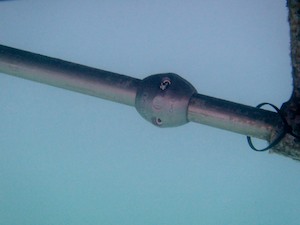
A new zinc is installed on the prop shaft
Over time, these zincs get eaten away by the electrolysis instead, sparing the prop shaft and blades’ slightly harder metal.
However, the zincs are not that easy to install. Mark makes it look like a piece of cake, completing the task in just a few free dives. I would be spluttering and drowning and would probably drop the screw driver or the zinc in the sand deep below the boat, never to be found again…
Bountiful fresh water is critical to a comfortable life aboard, and we get our fresh water from a “watermaker” that converts ocean water into drinking water.
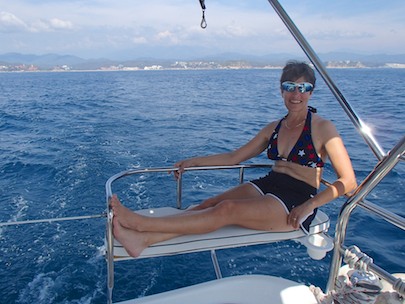
We go out to clean deep water to “make water”
This is a rather miraculous system, and our watermaker is enormous by cruising standards, converting 60 gallons of water an hour by pushing it through a strainer first (to remove the fish and sea creatures) then through two filters (to remove the algae) then through two 4′ long high pressure membranes (to remove the salt, bacteria and viruses).

Wow – clean water!! Such a special treat. Red tide is an unfortunate fact of life on Mexico’s Pacific coast.
The system is rated for 38 gallons an hour, but after the two membranes failed in our first season, the manufacturer (EchoTec) kindly replaced them with high capacity membranes, so now we fill a gallon jug in 63 seconds. It’s quite thrilling to watch. Shower water, toilet water and deck cleaning water all go into our holding tanks (140 gallons), but we keep our drinking water in gallon jugs as a habit held over from living in our trailer.
Mark hated the watermaker the first year. It was a bear to install due to inaccurate manuals, incomplete parts shipped to us, and difficult positions for the various parts in the boat. Plus, installation required fabricating a bracket to hang the high pressure pump from the engine.
To top it all off, the first membranes we received were dead on arrival. Then the replacement set failed after four months! Now, however, with great, working membranes, the watermaker is his pride and joy (“I want to keep it even if we sell the boat someday!” he joked recently). It is his favorite part of the boat.
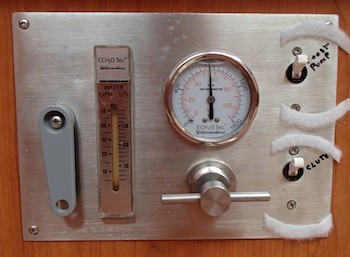
EchoTec’s main watermaker panel. At 800 psi the system pegs at 60 gph.

Mark runs a hose to the deck to wash it down as we make water
The purity of the water is measured by a TDS meter (“total dissolved solids”), and we found the San Diego water supply at our son’s apartment got readings of 350, and the FDA limit is 500. Our watermaker usually gives us readings between 75 and 95.
Most boats our size have systems that convert 6-13 gallons an hour. However, we’ve found the 60-gallon-an-hour flow is fast enough to be able to wash the deck and cockpit with a hose run out a hatch. This is a real boon at the end of a salty crossing or after sitting in a dusty area for a while. So, making water and/or washing the cockpit/deck is often on our day’s to-do list.
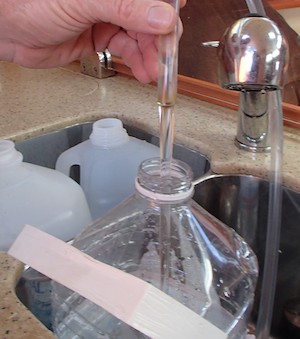
60 gallons per hour gives a good flow
Then there’s food. We are simple eaters, so our diet is pretty plain by most standards. In Mexico we’ve discovered many familiar foods can be found on store shelves, even if the packaging is in Spanish.
The most common bread available in Mexico is “Bimbo Bread,” which is equivalent to our Wonder Bread. But it turns out that Mexico’s Bimbo Bakeries actually owns the US brands Oroweat, Arnold, Thomas’s English Muffins and many others.
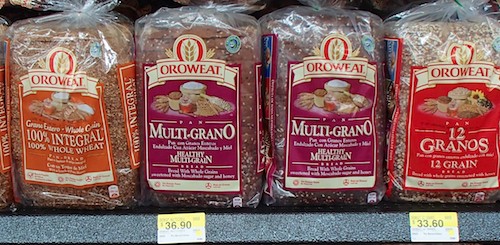
Oroweat Bread is owned by Mexico’s Bimbo Bakeries
We’ve found Oroweat breads in most supermarkets in Mexico, and the price of around $3 to $3.50 USD is comparable to home.
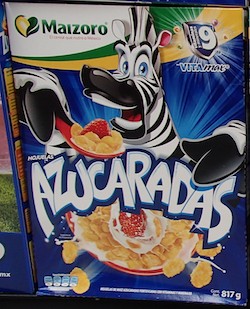
“Azucaradas” sounds & looks like kids’ sugar cereal

It helps to learn some of the basic food terms in Spanish: “avena” (oatmeal), “integral” (whole wheat), “grano entero” (whole grain), “pasas” (raisins) and “azucar” (sugar) are a few. So when you see a cereal called “Azucaradas” with a crazy, wild zebra on it, you can tell it’s probably a sugar cereal for kids!
In this age of jet-setting food, we’re used to seeing tomatoes from Mexico in the supermarkets in the US, but what a surprise to find Washington apples here in Mexico as well as organically grown California spinach.
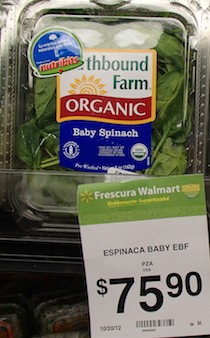
Did this spinach bring a passport?
This spinach was a bit wilted (it’s a long flight for a little leaf!), and the price was $6 USD a box. But it’s available.
Bean burritos are a common dinner aboard Groovy. They’re yummy, easy to make and don’t take a lot of ingredients. But I was amused when I asked our friend Andrés from southern Mexico if he’d like a bean burrito, and he responded, “Is that an American dish or a Mexican one?” What we always thought of as being so very Mexican isn’t really…

Matt Damon & Scarlett Johansson – We’ll take it!
At night we often settle in with a movie. TV reception is non-existent on the boat, but the bootleg DVD industry is alive and well in Mexico. DVD’s are sold on the street for 20 to 30 pesos apiece ($1.60-$2.40 USD). The titles often have no resemblance to the English titles, so you go by the actors’ names and hope for the best. Who knows what this one is, but with Matt Damon and Scarlett Johansson, it oughtta be okay!

Groovy is happily anchored off a lovely resort in Tangolunda Bay, Huatulco
So we live rather simply, floating in a tub on the ocean and washing our clothes in the sink! It’s a crazy life, but lately it has been fabulous.
Subscribe
Never miss a post — it’s free!
Other blog posts that give a glimpse of what it’s like to live on a sailboat:
- Oh, That’s Just Swell! – Life on a Boat that ROLLS At Anchor!! 05/17/13
- Snap, Crackle, Pop – Fishy Sounds from Deep Under Our Boat! 04/17/13
- The Tourist Tangle – All tied up in knots! 04/09/13
- And God said: “Let the Beer Flow” 03/30/13
- Showering on the hook = A carnival ride with your eyes closed! 03/28/13
- Surfing the dinghy = Crash landings on the beach! 03/18/13
- Swabbing the decks underway! 03/16/13
- Cruising = Fixing your boat in exotic places! 03/02/13
More funny stories from our Mexico cruise + Tips for planning your own sailing cruise
Our most recent posts:
- How to Install Starlink Gen 3 in an RV? Use the Speedmount! 08/07/25
- Escape to Paradise – Rocky Mountain Magic! 08/01/25
- Is Forest River a Good RV? Well Built? Here’s Our Experience 06/20/25
- Sunset Crater Nat’l Monument – Lava & Camels at Bonito CG! 06/06/25
- 2024 Alpha Wolf 17CB Trailer – Our Goldilocks RV! 04/25/25
More of our Latest Posts are in the MENU above.
